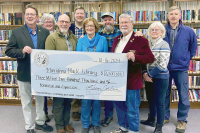A look back at Kephart’s cabin
As part of this coming weekend’s third annual Horace Kephart Day, a group of 20 or so participants will visit Kephart’s cabin site on Hazel Creek, where he resided from 1904-1907. In that regard, I thought it would be appropriate to revisit a Back Then column written in 2004, when his Our Southern Highlanders (1913) was being read throughout Western North Carolina as part of the “Together We Read” program.
Located two miles from Medlin, a tiny settlement situated where the Sugar Fork enters Hazel Creek about 10 miles from its confluence with the Little Tennessee River (now inundated, in part, by Lake Fontana), this remote cabin on the Little Fork became the vantage point from which Kephart studied the land and its people. It was a two-room structure, half of logs and half of rough planking, perhaps with two levels constructed at different times. He refurbished the dwelling, adding his few belongings once they were hauled up in a wagon.
One of the most revealing sources in regard to Kephart’s three years at the cabin is an interview conducted by F.A. Behymer published in the St. Louis Post Dispatch (12/12/26) under the heading “Horace Kephart, Driven from Library by Broken Health, Reborn in Woods.” Behymer, who apparently knew Kephart from his days as a librarian in St. Louis, visited Kephart in his office just off the town square in Bryson City.
“‘Seldom during those three years as a forest exile,’ Kephart said, ‘did I feel lonesome in the daytime; but when supper would be over and black night closed in on my hermitage, and the owls began calling all the blue devils of the woods, one needed some indoor occupation to keep him in good cheer.’
“It was the old life calling, the life of books that he had left,” Behymer noted. “For such a man there could be a beginning again but the old life could not be entirely disowned …. Out of the thousands of books that he had intimately known [as a librarian] there were only a few he could carry with him into the solitudes. He selected them with care, 20 of them. Here is the list in the order in which they stood on a shelf on his soap-box cupboard:
an English dictionary; Roget’s Thesaurus; his sister’s Bible; Shakespeare; Burns’ Poems; Dante (in Italian); Goethe’s Faust; Poe’s Tales; Stevenson’s Kidnapped, David Balfour and The Merry Men; Fisher’s Universal History; Nessmuk’s [i.e., George Washington Sears] Woodcraft; Frazer’s Minerals; Jordan’s Vertebrate Animals; Wright’s Birdcraft; Matthews’ American Wild Flowers; Keeler’s Our Native Trees; and Lounsberry’s Southern Wild Flowers and Trees. The old man had become a new man, but the new man was a man of books … and when the owls began calling, it was in his books that he found comfort. He took up writing, as it was inevitable that he would, setting down by night his experiences of the day.”
Related Items
Kephart became preoccupied with the simple and direct challenge of living efficiently in this new environment. Despite his extensive experiences in the outdoors dating back to childhood, he found that he now “had to make shift in a different way, and fashion many appliances from the materials found on the spot. The forest itself was not only my hunting-ground but my workshop and my garden ... I gathered, cooked, and ate (with certain qualms, be it confessed, but never with serious mishap) a great variety of wild plants that country folk in general do not know to be edible. I learned better ways of dressing and keeping game and fish, and worked out odd makeshifts in cooking with rude utensils, or with none at all. I tested the fuel values and other qualities of many kinds of wood and bark, made leather and rawhide from game that fell to my rifle, and became more or less adept in other backwood handicrafts, seeking not novelties but practical results.”
These “practical results” he published in the popular outdoor magazines of the day. By 1906, he had compiled enough material to put together the first edition of The Book of Camping and Woodcraft, a storehouse of practical advice, lore, anecdote, and adventure that in expanded editions re-titled Camping and Woodcraft became the standard work in its field, supremely applicable as is no other book in regard to basic techniques and philosophy.
After leaving Hazel Creek in 1907, Kephart considered returning there when he came back to the Smokies in 1910. Because the Ritter Lumber Company had begun extensive operations up the entire watershed the previous year, he decided to locate in Bryson City instead.
But those three years in the cabin on the Little Fork stimulated Kephart’s imagination and writing. It was the place where he sorted out his life and laid the foundation for what became a substantial literary and environmental legacy. When he observed toward the end of his life that, “I owe my life to these mountains,” he no doubt had the Little Fork of the Sugar Fork of Hazel Creek years in mind.
George Ellison wrote the biographical introductions for the reissues of two Appalachian classics: Horace Kephart’s Our Southern Highlanders and James Mooney’s History, Myths, and Sacred Formulas of the Cherokees. In June 2005, a selection of his Back Then columns was published by The History Press in Charleston as Mountain Passages: Natural and Cultural History of Western North Carolina and the Great Smoky Mountains. Readers can contact him at P.O. Box 1262, Bryson City, N.C., 28713, or at This email address is being protected from spambots. You need JavaScript enabled to view it..









